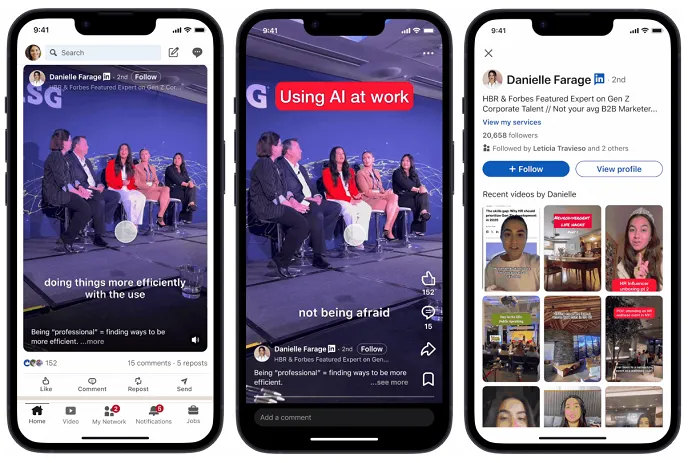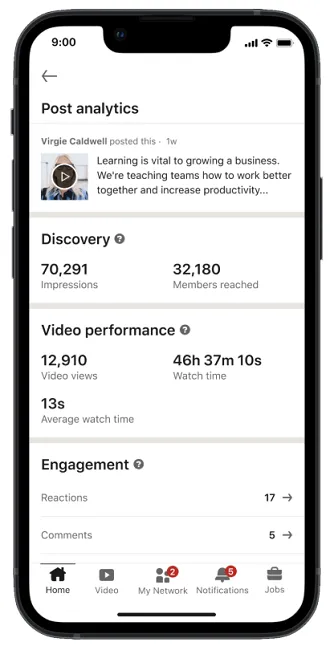- AI |
- 5 min read
Hi,
Get in touch with us today to chat about your next project.
LinkedIn has evolved from a digital résumé platform into the go-to hub for professional networking and B2B marketing. Recent updates to its interface have made video content more prominent, with larger displays and immersive, full-screen experiences. As B2B businesses compete for attention, leveraging video has become essential to standing out in a crowded feed. If you’re not using video on LinkedIn yet, now is the time to start.

LinkedIn has rolled out significant updates to its user interface, enhancing how video content is presented and discovered across both desktop and mobile platforms. These changes are designed to make video posts more prominent, encouraging deeper engagement from users and providing businesses with greater opportunities to connect with their audience.
Full-Screen Video Experience on Desktop: LinkedIn has expanded its full-screen, vertical video format to desktop users, creating a seamless experience between desktop and mobile. Users can now view videos from their feed or the ‘Videos for You’ module in an immersive, full-screen display, offering a more engaging way to consume video content.
Enhanced Mobile Video Display: LinkedIn is testing a larger video format in its mobile app, making videos appear in longer, wider frames directly within the feed. Additionally, tapping on a creator’s profile now reveals a mini-overview of their video uploads, making it easier to discover and engage with a creator’s content.

New Video Analytics: New video analytics are being rolled out too, with data on average watch time to help you better understand individual video performance.
These updates demonstrate LinkedIn’s commitment to prioritizing video as a core content format, acknowledging its growing role in professional networking, brand building, and audience engagement. For B2B businesses, this shift underscores the importance of integrating video into their LinkedIn strategies to stay competitive and visible.
For B2B audiences, video breaks down complex information into digestible, engaging content. It allows companies to humanize their brand by featuring real people and success stories, which builds trust and credibility. Video also boosts retention—viewers are far more likely to remember your message compared to reading text alone. In industries where relationships and expertise matter, video creates a lasting impression.
Video content enjoys higher engagement rates, often leading to increased visibility and stronger brand awareness. It’s an effective tool for generating leads, as videos can drive up to 80% more conversions than static content. Personalized, authentic videos foster deeper connections with your audience, building trust over time. Additionally, videos improve message retention, making it easier to communicate complex ideas.
Formats: Expert interviews, industry insights, and professional advice.
👉 Use interviews to capture authentic insights from industry leaders to position your brand as a thought leader.
Example:
Formats: Client testimonials, success stories, and real-world results.
👉 Use customer stories and case studies to showcase the value your business delivers through compelling narratives from satisfied clients.
Example:
Formats: Office tours, team highlights, and company milestones.
👉 Use people stories to highlight your brand’s personality and company’s culture by showcasing your team, company culture, and internal success stories.
Example:
Formats: Conference highlights, panel discussions, and live-streamed events.
👉 Use events and live stream video to capture key moments from corporate events or conferences for broader engagement.
Example:
Formats: How-to guides, explainer videos, and product demonstrations.
👉 Use help & how-to and product demo video formats to simplify complex topics through step-by-step guides or showcase your product features effectively.
Example:
Keep your videos concise—under one minute tends to yield the best engagement. Since many users watch videos on mute, add captions to ensure your message is still clear. Optimize for mobile viewing with vertical formats and clear visuals. Always include a compelling call-to-action (CTA) to guide viewers on the next step, whether it’s visiting your website or engaging with the post.
Many B2B brands have already found success using video on LinkedIn. Companies like HubSpot and IBM use short-form video content to share insights and drive engagement. Case studies featuring client success stories have helped brands build credibility and attract new leads. The common thread? These companies prioritize authenticity and deliver real value to their audiences.
Video on LinkedIn isn’t just a trend—it’s an essential tool for B2B businesses looking to stay relevant. The platform’s recent changes are designed to elevate video content, making now the perfect time to invest in this format. Whether you’re sharing thought leadership or showcasing customer success, video will help your brand stand out and drive meaningful engagement. Start small, experiment with different formats, and watch your LinkedIn presence grow.